Liquidity and Profitability: Sri Lankan Manufacturing Companies
VerifiedAdded on 2022/01/13
|38
|11809
|48
Thesis and Dissertation
AI Summary
This dissertation, submitted by T.S.L. Rupasinghe to the University of Ruhuna in partial fulfillment of a Bachelor's degree, investigates the relationship between liquidity and profitability in the context of listed manufacturing companies in Sri Lanka. The study examines the impact of liquidity ratios, specifically current and quick ratios, on profitability measures such as Return on Assets (ROA), Return on Equity (ROE), and Return on Sales (ROS). Using secondary data from 15 manufacturing companies listed on the Colombo Stock Exchange from 2008 to 2012, the research employs correlation and regression analyses to determine the nature and extent of the relationship between liquidity and profitability. The findings suggest a significant relationship between liquidity and profitability, although the influence of liquidity on profitability is found to be relatively low, with the quick ratio not showing a significant relationship with ROE. The study aims to contribute to the understanding of financial management practices and inform decision-making for both internal and external stakeholders of Sri Lankan manufacturing companies.
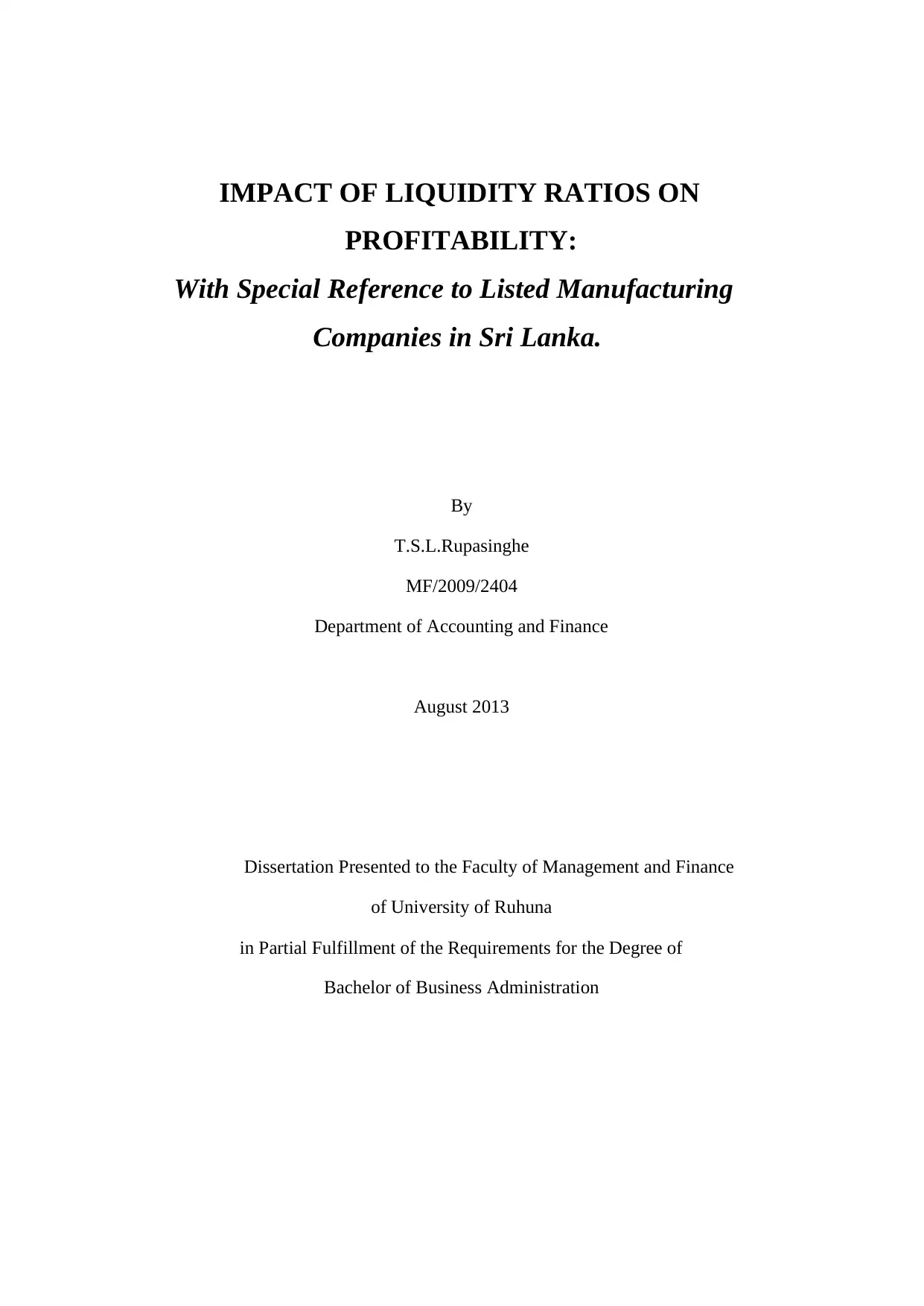
IMPACT OF LIQUIDITY RATIOS ON
PROFITABILITY:
With Special Reference to Listed Manufacturing
Companies in Sri Lanka.
By
T.S.L.Rupasinghe
MF/2009/2404
Department of Accounting and Finance
August 2013
Dissertation Presented to the Faculty of Management and Finance
of University of Ruhuna
in Partial Fulfillment of the Requirements for the Degree of
Bachelor of Business Administration
PROFITABILITY:
With Special Reference to Listed Manufacturing
Companies in Sri Lanka.
By
T.S.L.Rupasinghe
MF/2009/2404
Department of Accounting and Finance
August 2013
Dissertation Presented to the Faculty of Management and Finance
of University of Ruhuna
in Partial Fulfillment of the Requirements for the Degree of
Bachelor of Business Administration
Paraphrase This Document
Need a fresh take? Get an instant paraphrase of this document with our AI Paraphraser
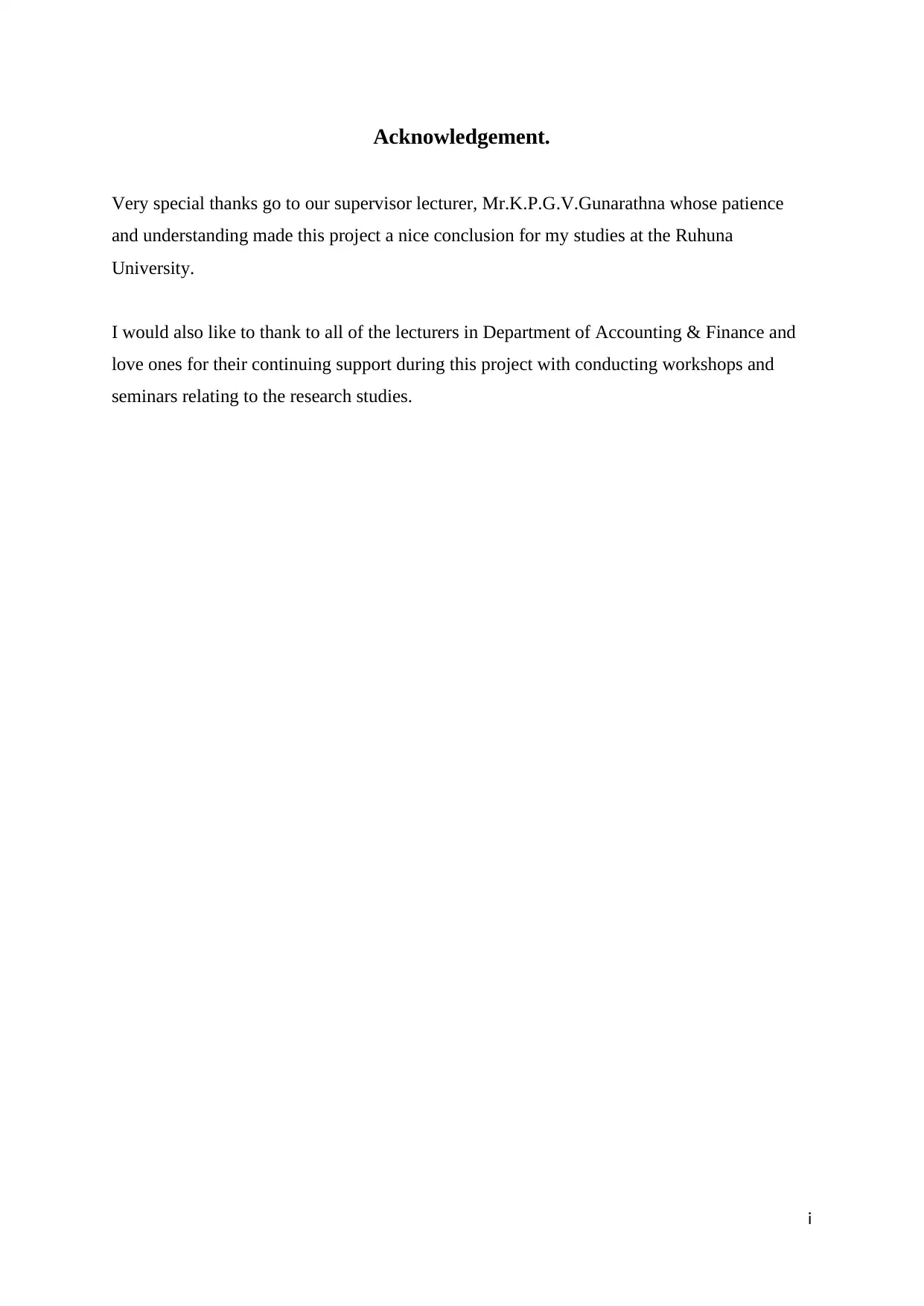
i
Acknowledgement.
Very special thanks go to our supervisor lecturer, Mr.K.P.G.V.Gunarathna whose patience
and understanding made this project a nice conclusion for my studies at the Ruhuna
University.
I would also like to thank to all of the lecturers in Department of Accounting & Finance and
love ones for their continuing support during this project with conducting workshops and
seminars relating to the research studies.
Acknowledgement.
Very special thanks go to our supervisor lecturer, Mr.K.P.G.V.Gunarathna whose patience
and understanding made this project a nice conclusion for my studies at the Ruhuna
University.
I would also like to thank to all of the lecturers in Department of Accounting & Finance and
love ones for their continuing support during this project with conducting workshops and
seminars relating to the research studies.
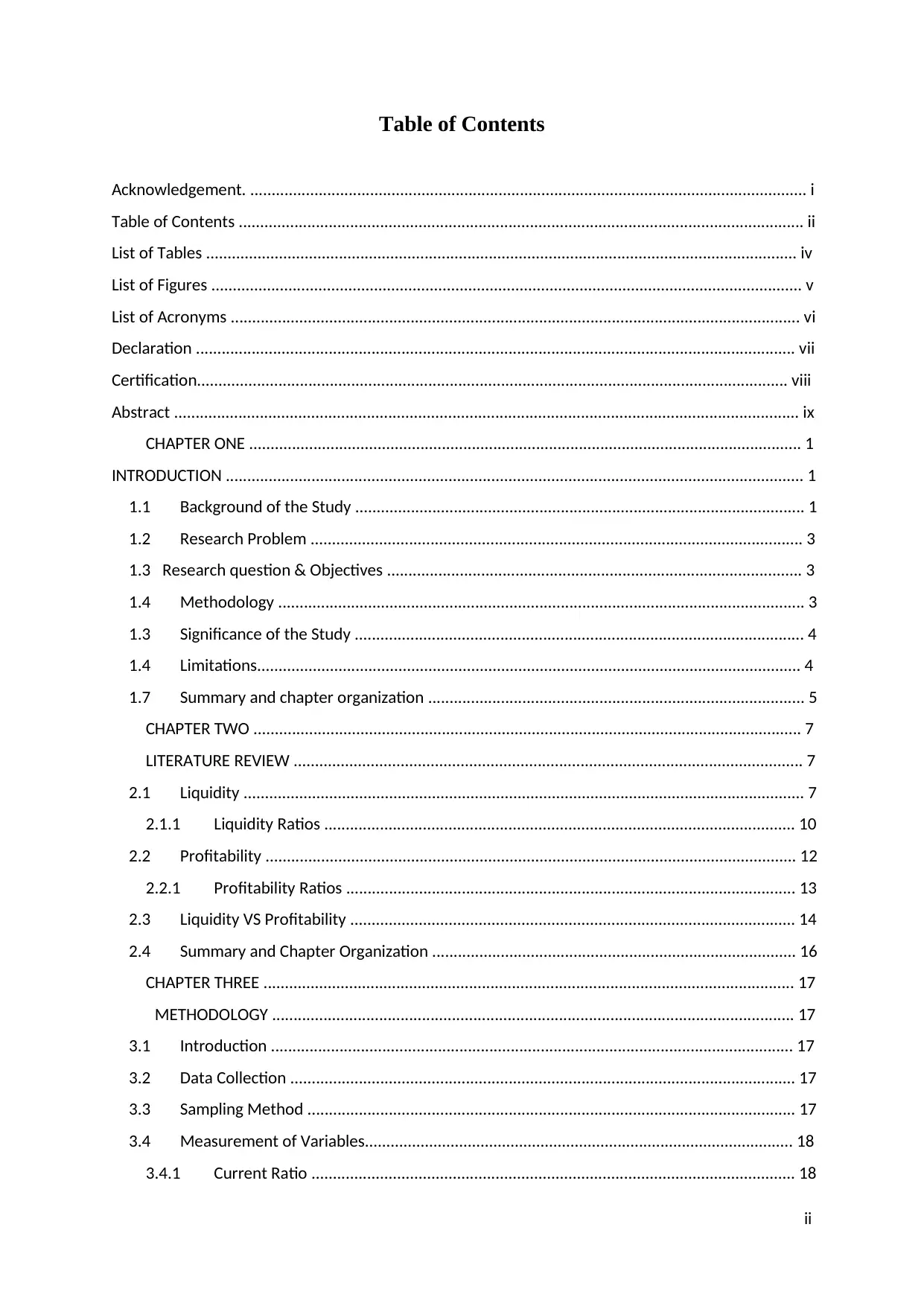
ii
Table of Contents
Acknowledgement. .................................................................................................................................. i
Table of Contents .................................................................................................................................... ii
List of Tables .......................................................................................................................................... iv
List of Figures .......................................................................................................................................... v
List of Acronyms ..................................................................................................................................... vi
Declaration ............................................................................................................................................ vii
Certification.......................................................................................................................................... viii
Abstract .................................................................................................................................................. ix
CHAPTER ONE ................................................................................................................................. 1
INTRODUCTION ....................................................................................................................................... 1
1.1 Background of the Study ......................................................................................................... 1
1.2 Research Problem ................................................................................................................... 3
1.3 Research question & Objectives ................................................................................................. 3
1.4 Methodology ........................................................................................................................... 3
1.3 Significance of the Study ......................................................................................................... 4
1.4 Limitations............................................................................................................................... 4
1.7 Summary and chapter organization ........................................................................................ 5
CHAPTER TWO ................................................................................................................................ 7
LITERATURE REVIEW ....................................................................................................................... 7
2.1 Liquidity ................................................................................................................................... 7
2.1.1 Liquidity Ratios .............................................................................................................. 10
2.2 Profitability ............................................................................................................................ 12
2.2.1 Profitability Ratios ......................................................................................................... 13
2.3 Liquidity VS Profitability ........................................................................................................ 14
2.4 Summary and Chapter Organization ..................................................................................... 16
CHAPTER THREE ............................................................................................................................ 17
METHODOLOGY .......................................................................................................................... 17
3.1 Introduction .......................................................................................................................... 17
3.2 Data Collection ...................................................................................................................... 17
3.3 Sampling Method .................................................................................................................. 17
3.4 Measurement of Variables.................................................................................................... 18
3.4.1 Current Ratio ................................................................................................................. 18
Table of Contents
Acknowledgement. .................................................................................................................................. i
Table of Contents .................................................................................................................................... ii
List of Tables .......................................................................................................................................... iv
List of Figures .......................................................................................................................................... v
List of Acronyms ..................................................................................................................................... vi
Declaration ............................................................................................................................................ vii
Certification.......................................................................................................................................... viii
Abstract .................................................................................................................................................. ix
CHAPTER ONE ................................................................................................................................. 1
INTRODUCTION ....................................................................................................................................... 1
1.1 Background of the Study ......................................................................................................... 1
1.2 Research Problem ................................................................................................................... 3
1.3 Research question & Objectives ................................................................................................. 3
1.4 Methodology ........................................................................................................................... 3
1.3 Significance of the Study ......................................................................................................... 4
1.4 Limitations............................................................................................................................... 4
1.7 Summary and chapter organization ........................................................................................ 5
CHAPTER TWO ................................................................................................................................ 7
LITERATURE REVIEW ....................................................................................................................... 7
2.1 Liquidity ................................................................................................................................... 7
2.1.1 Liquidity Ratios .............................................................................................................. 10
2.2 Profitability ............................................................................................................................ 12
2.2.1 Profitability Ratios ......................................................................................................... 13
2.3 Liquidity VS Profitability ........................................................................................................ 14
2.4 Summary and Chapter Organization ..................................................................................... 16
CHAPTER THREE ............................................................................................................................ 17
METHODOLOGY .......................................................................................................................... 17
3.1 Introduction .......................................................................................................................... 17
3.2 Data Collection ...................................................................................................................... 17
3.3 Sampling Method .................................................................................................................. 17
3.4 Measurement of Variables.................................................................................................... 18
3.4.1 Current Ratio ................................................................................................................. 18
⊘ This is a preview!⊘
Do you want full access?
Subscribe today to unlock all pages.

Trusted by 1+ million students worldwide
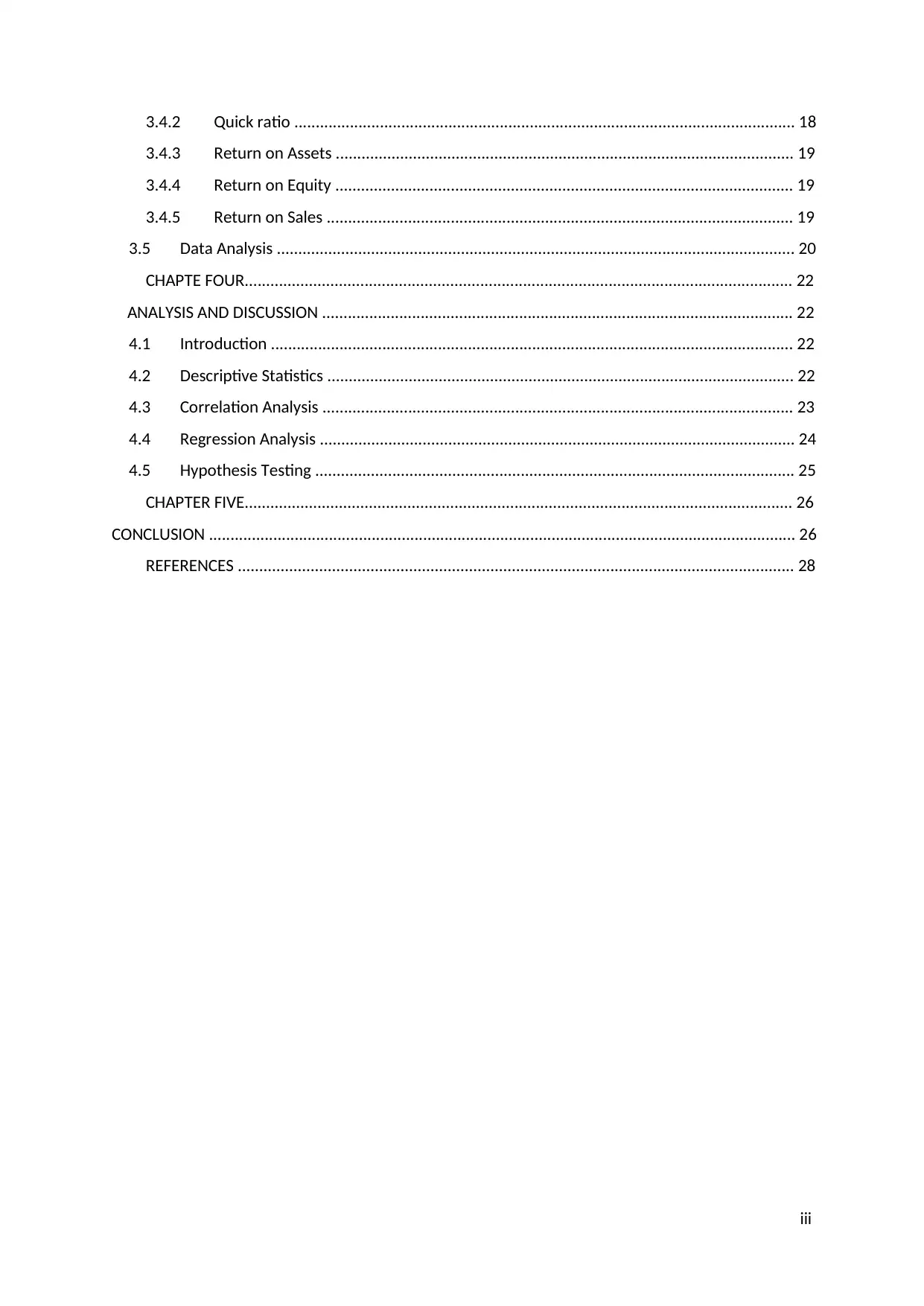
iii
3.4.2 Quick ratio ..................................................................................................................... 18
3.4.3 Return on Assets ........................................................................................................... 19
3.4.4 Return on Equity ........................................................................................................... 19
3.4.5 Return on Sales ............................................................................................................. 19
3.5 Data Analysis ......................................................................................................................... 20
CHAPTE FOUR................................................................................................................................ 22
ANALYSIS AND DISCUSSION .............................................................................................................. 22
4.1 Introduction .......................................................................................................................... 22
4.2 Descriptive Statistics ............................................................................................................. 22
4.3 Correlation Analysis .............................................................................................................. 23
4.4 Regression Analysis ............................................................................................................... 24
4.5 Hypothesis Testing ................................................................................................................ 25
CHAPTER FIVE................................................................................................................................ 26
CONCLUSION ......................................................................................................................................... 26
REFERENCES .................................................................................................................................. 28
3.4.2 Quick ratio ..................................................................................................................... 18
3.4.3 Return on Assets ........................................................................................................... 19
3.4.4 Return on Equity ........................................................................................................... 19
3.4.5 Return on Sales ............................................................................................................. 19
3.5 Data Analysis ......................................................................................................................... 20
CHAPTE FOUR................................................................................................................................ 22
ANALYSIS AND DISCUSSION .............................................................................................................. 22
4.1 Introduction .......................................................................................................................... 22
4.2 Descriptive Statistics ............................................................................................................. 22
4.3 Correlation Analysis .............................................................................................................. 23
4.4 Regression Analysis ............................................................................................................... 24
4.5 Hypothesis Testing ................................................................................................................ 25
CHAPTER FIVE................................................................................................................................ 26
CONCLUSION ......................................................................................................................................... 26
REFERENCES .................................................................................................................................. 28
Paraphrase This Document
Need a fresh take? Get an instant paraphrase of this document with our AI Paraphraser
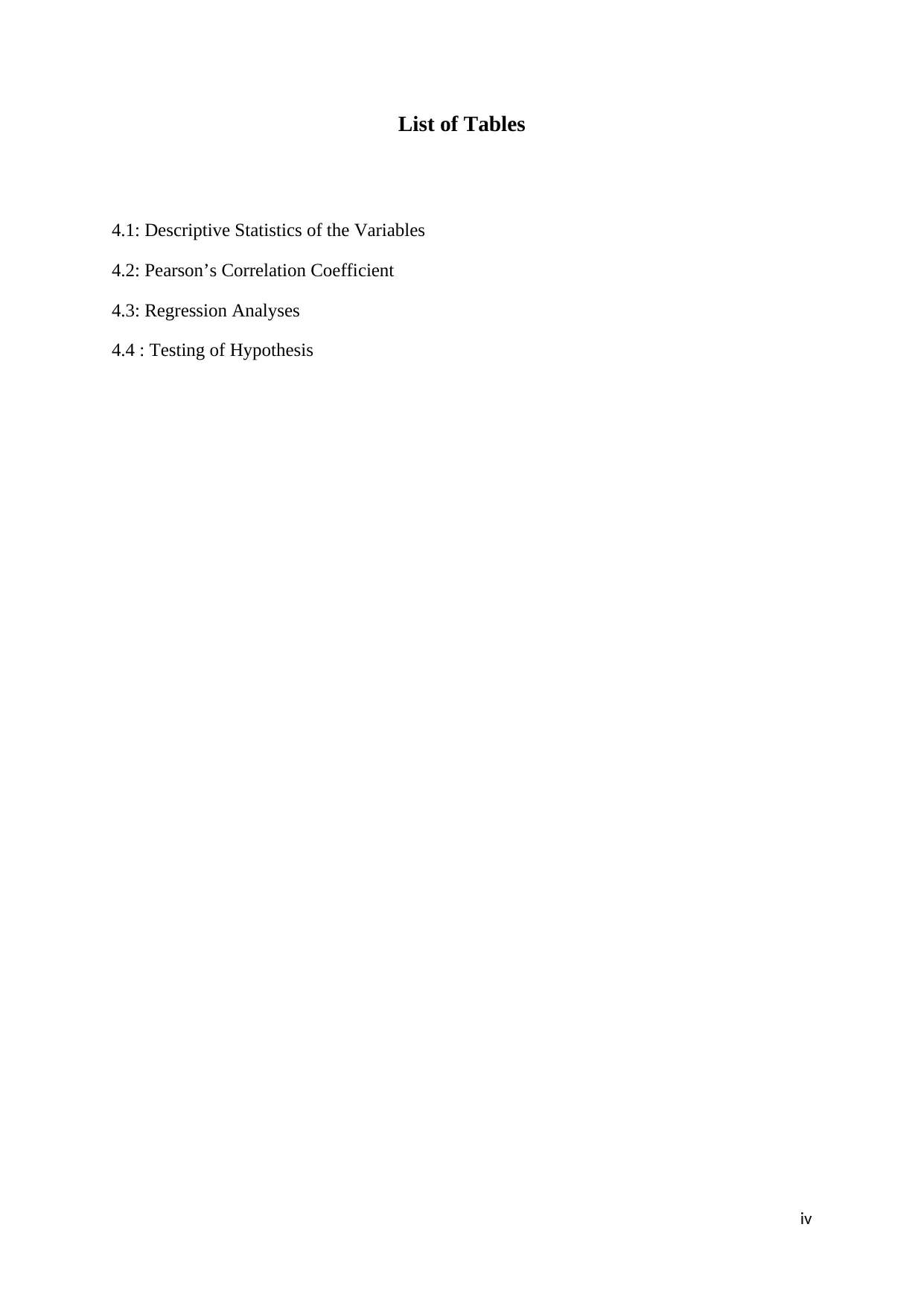
iv
List of Tables
4.1: Descriptive Statistics of the Variables
4.2: Pearson’s Correlation Coefficient
4.3: Regression Analyses
4.4 : Testing of Hypothesis
List of Tables
4.1: Descriptive Statistics of the Variables
4.2: Pearson’s Correlation Coefficient
4.3: Regression Analyses
4.4 : Testing of Hypothesis
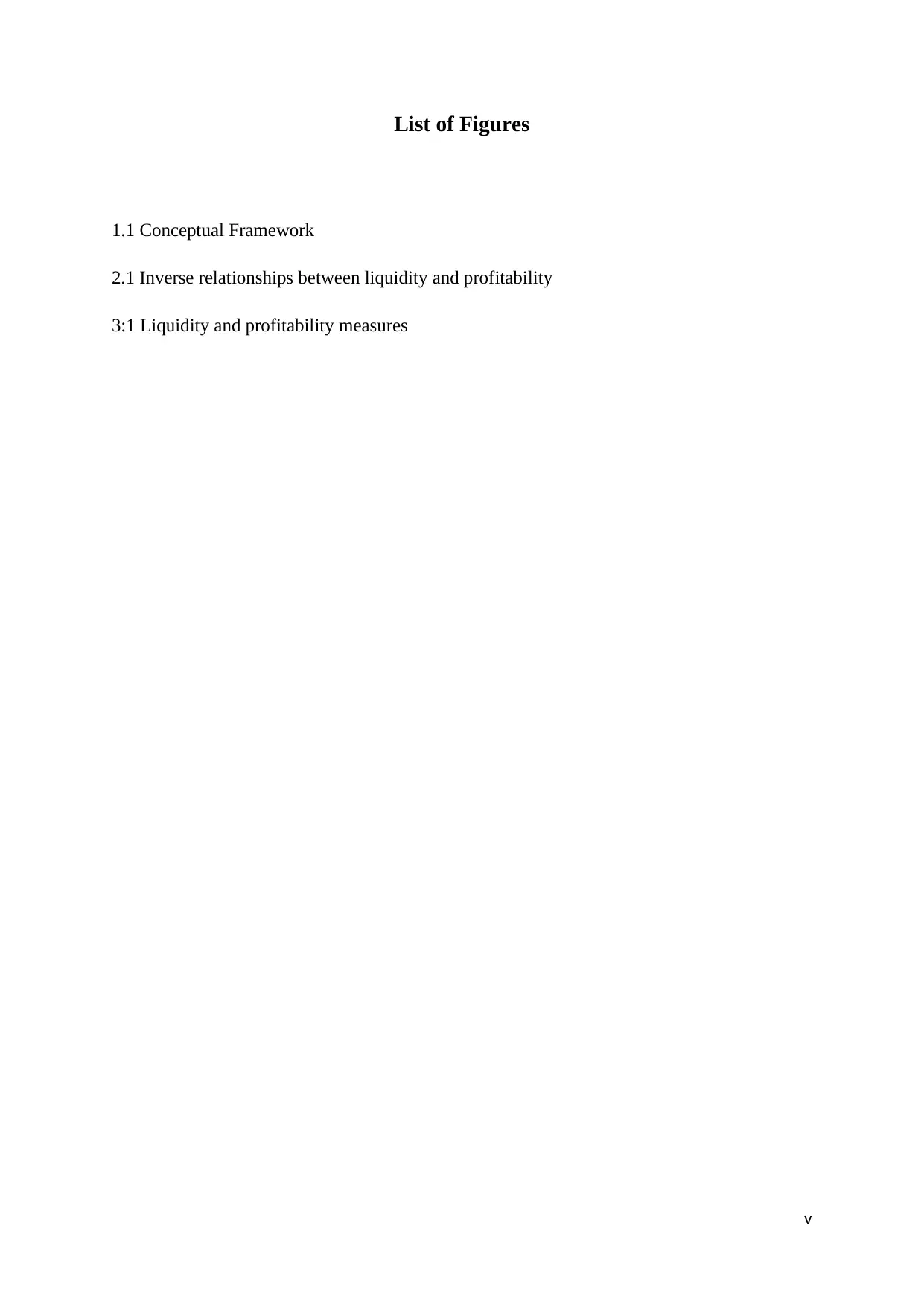
v
List of Figures
1.1 Conceptual Framework
2.1 Inverse relationships between liquidity and profitability
3:1 Liquidity and profitability measures
List of Figures
1.1 Conceptual Framework
2.1 Inverse relationships between liquidity and profitability
3:1 Liquidity and profitability measures
⊘ This is a preview!⊘
Do you want full access?
Subscribe today to unlock all pages.

Trusted by 1+ million students worldwide
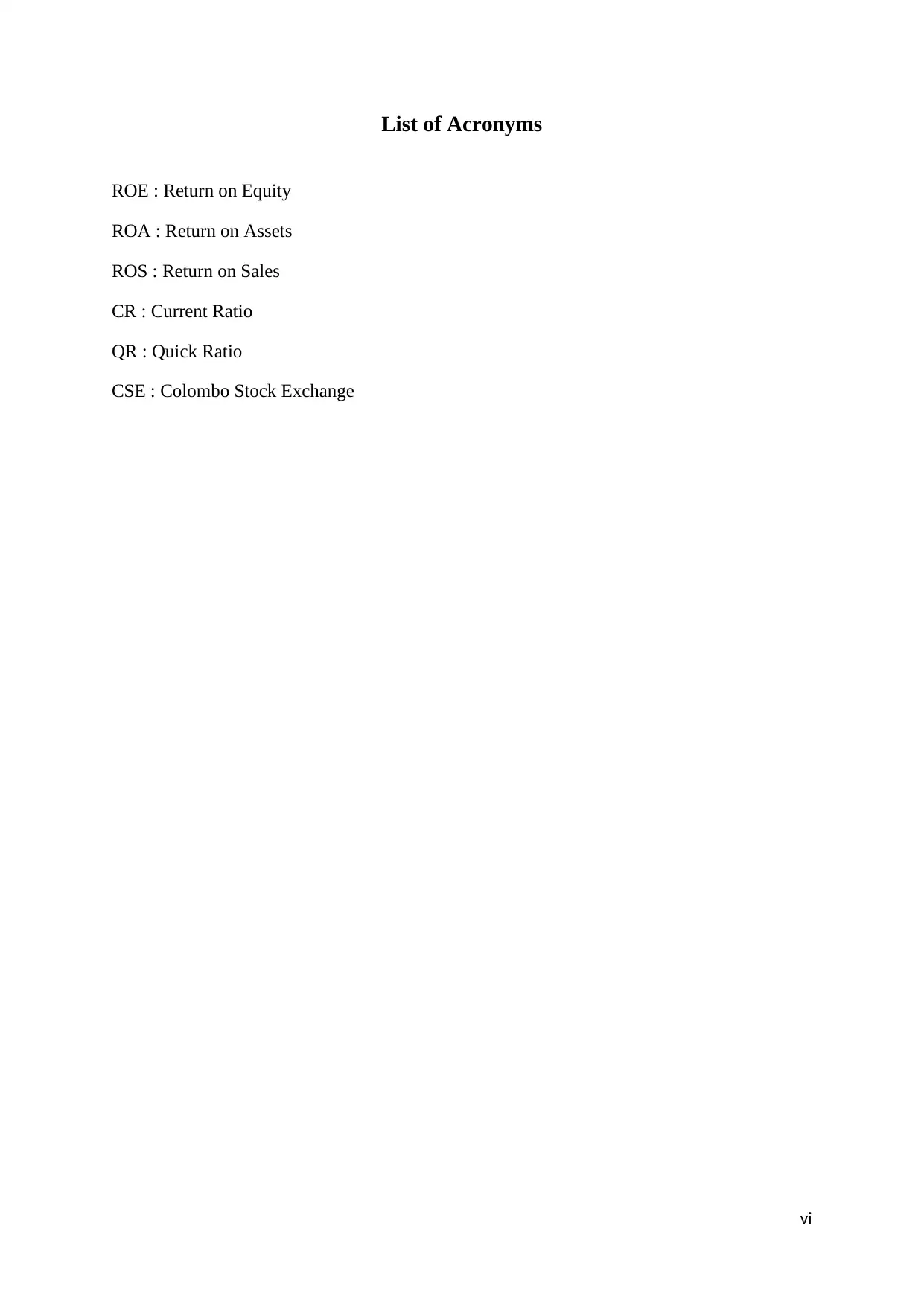
vi
List of Acronyms
ROE : Return on Equity
ROA : Return on Assets
ROS : Return on Sales
CR : Current Ratio
QR : Quick Ratio
CSE : Colombo Stock Exchange
List of Acronyms
ROE : Return on Equity
ROA : Return on Assets
ROS : Return on Sales
CR : Current Ratio
QR : Quick Ratio
CSE : Colombo Stock Exchange
Paraphrase This Document
Need a fresh take? Get an instant paraphrase of this document with our AI Paraphraser
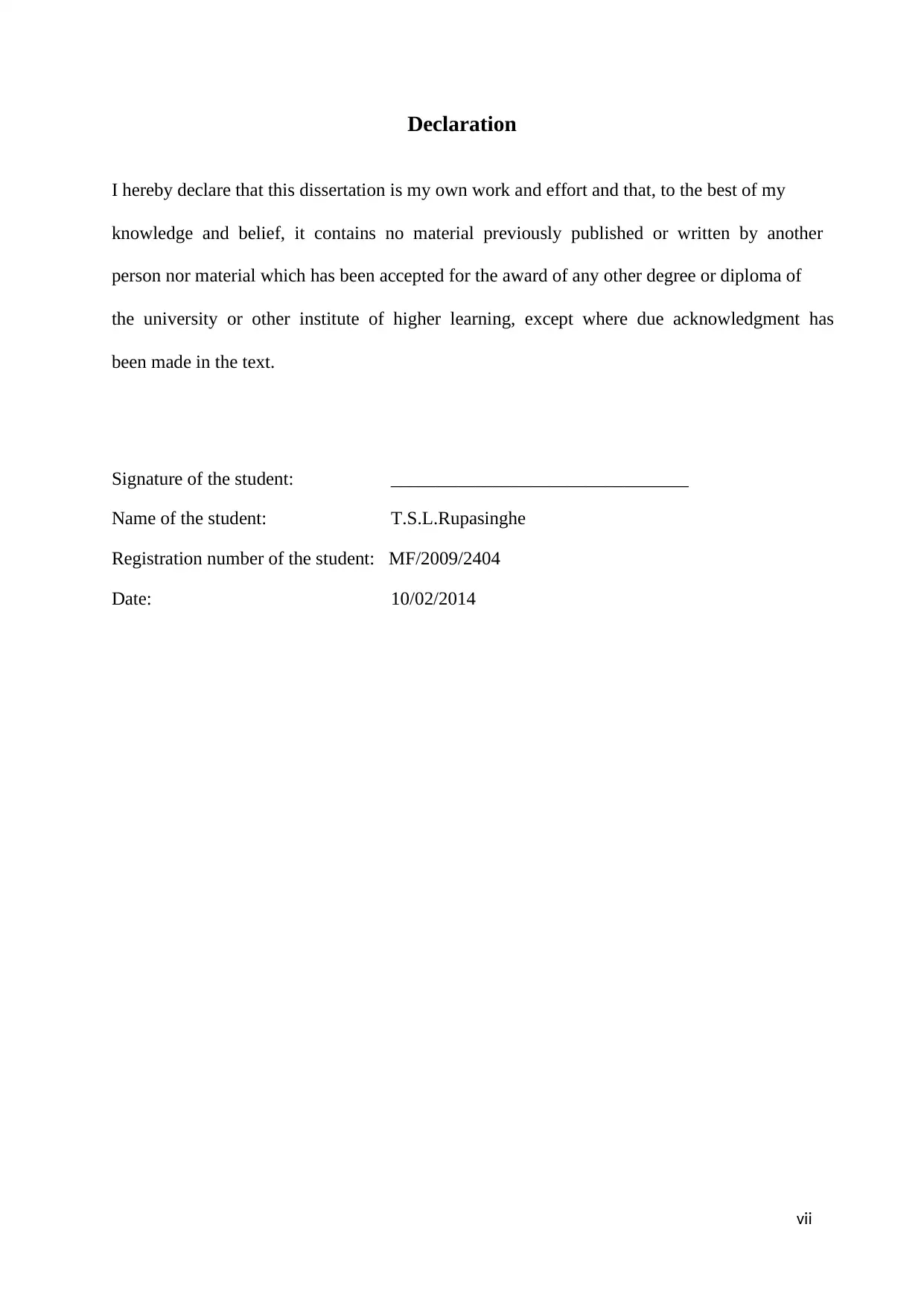
vii
Declaration
I hereby declare that this dissertation is my own work and effort and that, to the best of my
knowledge and belief, it contains no material previously published or written by another
person nor material which has been accepted for the award of any other degree or diploma of
the university or other institute of higher learning, except where due acknowledgment has
been made in the text.
Signature of the student: ________________________________
Name of the student: T.S.L.Rupasinghe
Registration number of the student: MF/2009/2404
Date: 10/02/2014
Declaration
I hereby declare that this dissertation is my own work and effort and that, to the best of my
knowledge and belief, it contains no material previously published or written by another
person nor material which has been accepted for the award of any other degree or diploma of
the university or other institute of higher learning, except where due acknowledgment has
been made in the text.
Signature of the student: ________________________________
Name of the student: T.S.L.Rupasinghe
Registration number of the student: MF/2009/2404
Date: 10/02/2014
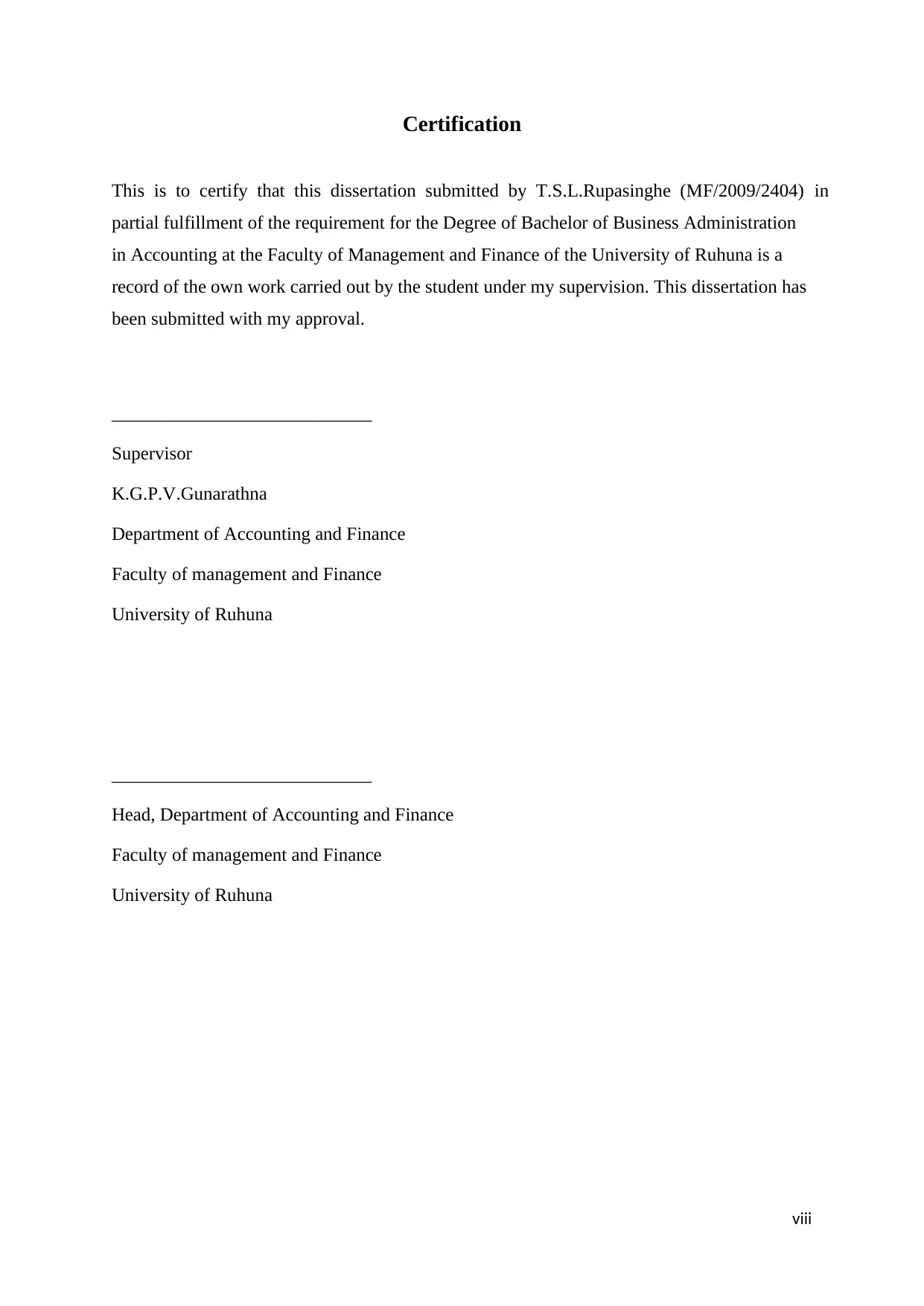
viii
Certification
This is to certify that this dissertation submitted by T.S.L.Rupasinghe (MF/2009/2404) in
partial fulfillment of the requirement for the Degree of Bachelor of Business Administration
in Accounting at the Faculty of Management and Finance of the University of Ruhuna is a
record of the own work carried out by the student under my supervision. This dissertation has
been submitted with my approval.
____________________________
Supervisor
K.G.P.V.Gunarathna
Department of Accounting and Finance
Faculty of management and Finance
University of Ruhuna
____________________________
Head, Department of Accounting and Finance
Faculty of management and Finance
University of Ruhuna
Certification
This is to certify that this dissertation submitted by T.S.L.Rupasinghe (MF/2009/2404) in
partial fulfillment of the requirement for the Degree of Bachelor of Business Administration
in Accounting at the Faculty of Management and Finance of the University of Ruhuna is a
record of the own work carried out by the student under my supervision. This dissertation has
been submitted with my approval.
____________________________
Supervisor
K.G.P.V.Gunarathna
Department of Accounting and Finance
Faculty of management and Finance
University of Ruhuna
____________________________
Head, Department of Accounting and Finance
Faculty of management and Finance
University of Ruhuna
⊘ This is a preview!⊘
Do you want full access?
Subscribe today to unlock all pages.

Trusted by 1+ million students worldwide
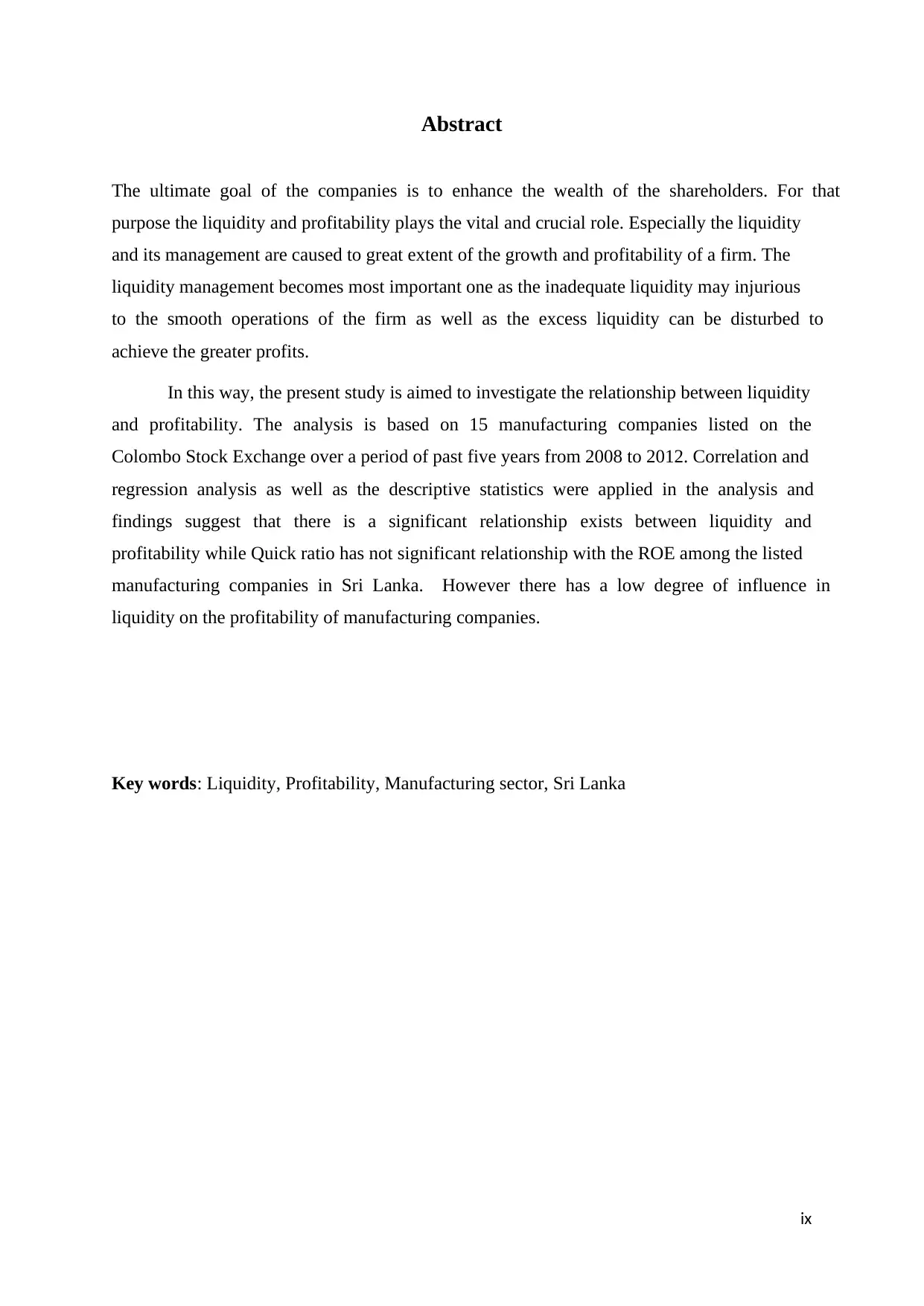
ix
Abstract
The ultimate goal of the companies is to enhance the wealth of the shareholders. For that
purpose the liquidity and profitability plays the vital and crucial role. Especially the liquidity
and its management are caused to great extent of the growth and profitability of a firm. The
liquidity management becomes most important one as the inadequate liquidity may injurious
to the smooth operations of the firm as well as the excess liquidity can be disturbed to
achieve the greater profits.
In this way, the present study is aimed to investigate the relationship between liquidity
and profitability. The analysis is based on 15 manufacturing companies listed on the
Colombo Stock Exchange over a period of past five years from 2008 to 2012. Correlation and
regression analysis as well as the descriptive statistics were applied in the analysis and
findings suggest that there is a significant relationship exists between liquidity and
profitability while Quick ratio has not significant relationship with the ROE among the listed
manufacturing companies in Sri Lanka. However there has a low degree of influence in
liquidity on the profitability of manufacturing companies.
Key words: Liquidity, Profitability, Manufacturing sector, Sri Lanka
Abstract
The ultimate goal of the companies is to enhance the wealth of the shareholders. For that
purpose the liquidity and profitability plays the vital and crucial role. Especially the liquidity
and its management are caused to great extent of the growth and profitability of a firm. The
liquidity management becomes most important one as the inadequate liquidity may injurious
to the smooth operations of the firm as well as the excess liquidity can be disturbed to
achieve the greater profits.
In this way, the present study is aimed to investigate the relationship between liquidity
and profitability. The analysis is based on 15 manufacturing companies listed on the
Colombo Stock Exchange over a period of past five years from 2008 to 2012. Correlation and
regression analysis as well as the descriptive statistics were applied in the analysis and
findings suggest that there is a significant relationship exists between liquidity and
profitability while Quick ratio has not significant relationship with the ROE among the listed
manufacturing companies in Sri Lanka. However there has a low degree of influence in
liquidity on the profitability of manufacturing companies.
Key words: Liquidity, Profitability, Manufacturing sector, Sri Lanka
Paraphrase This Document
Need a fresh take? Get an instant paraphrase of this document with our AI Paraphraser
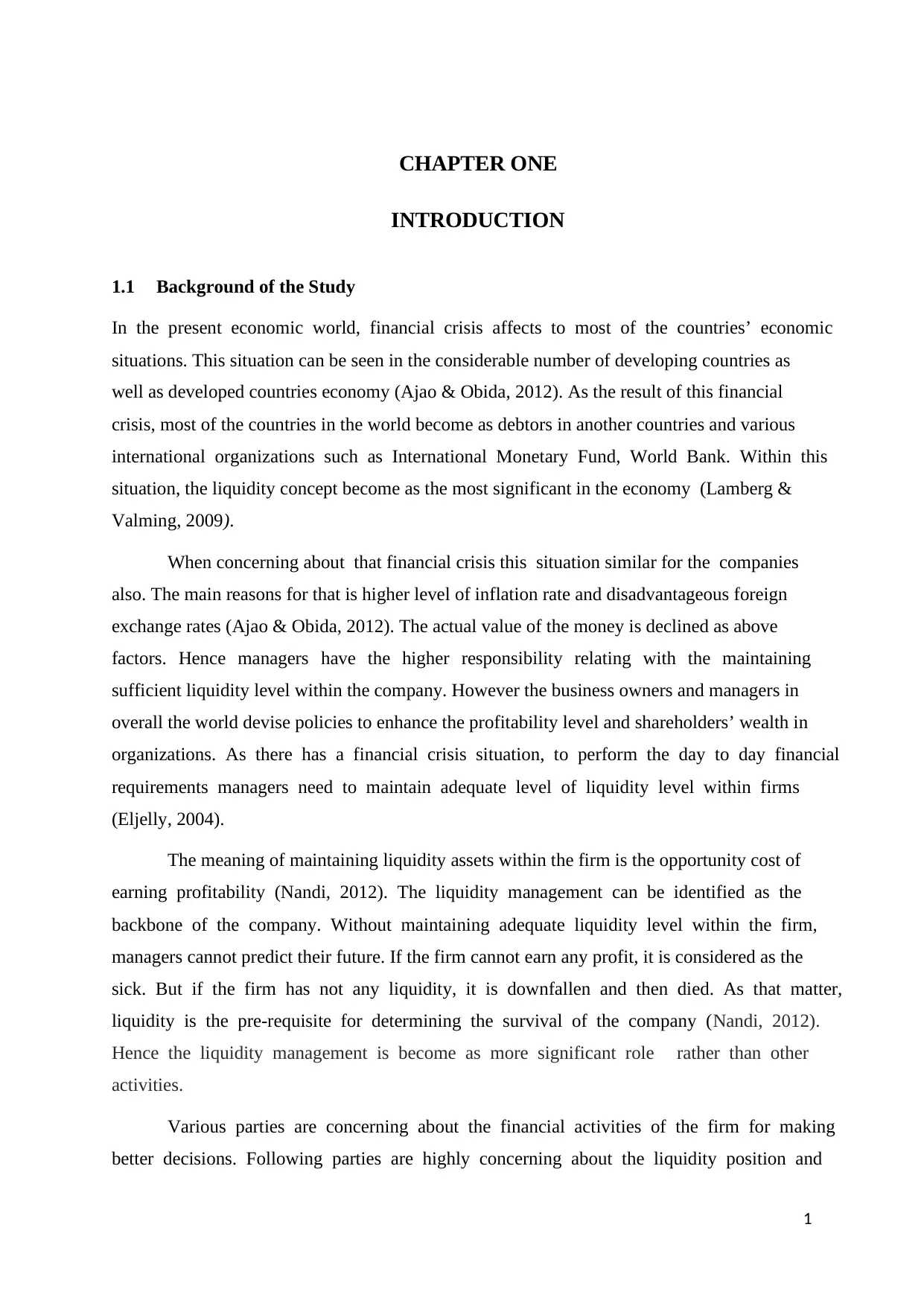
1
1 CHAPTER ONE
INTRODUCTION
1.1 Background of the Study
In the present economic world, financial crisis affects to most of the countries’ economic
situations. This situation can be seen in the considerable number of developing countries as
well as developed countries economy (Ajao & Obida, 2012). As the result of this financial
crisis, most of the countries in the world become as debtors in another countries and various
international organizations such as International Monetary Fund, World Bank. Within this
situation, the liquidity concept become as the most significant in the economy (Lamberg &
Valming, 2009).
When concerning about that financial crisis this situation similar for the companies
also. The main reasons for that is higher level of inflation rate and disadvantageous foreign
exchange rates (Ajao & Obida, 2012). The actual value of the money is declined as above
factors. Hence managers have the higher responsibility relating with the maintaining
sufficient liquidity level within the company. However the business owners and managers in
overall the world devise policies to enhance the profitability level and shareholders’ wealth in
organizations. As there has a financial crisis situation, to perform the day to day financial
requirements managers need to maintain adequate level of liquidity level within firms
(Eljelly, 2004).
The meaning of maintaining liquidity assets within the firm is the opportunity cost of
earning profitability (Nandi, 2012). The liquidity management can be identified as the
backbone of the company. Without maintaining adequate liquidity level within the firm,
managers cannot predict their future. If the firm cannot earn any profit, it is considered as the
sick. But if the firm has not any liquidity, it is downfallen and then died. As that matter,
liquidity is the pre-requisite for determining the survival of the company (Nandi, 2012).
Hence the liquidity management is become as more significant role rather than other
activities.
Various parties are concerning about the financial activities of the firm for making
better decisions. Following parties are highly concerning about the liquidity position and
1 CHAPTER ONE
INTRODUCTION
1.1 Background of the Study
In the present economic world, financial crisis affects to most of the countries’ economic
situations. This situation can be seen in the considerable number of developing countries as
well as developed countries economy (Ajao & Obida, 2012). As the result of this financial
crisis, most of the countries in the world become as debtors in another countries and various
international organizations such as International Monetary Fund, World Bank. Within this
situation, the liquidity concept become as the most significant in the economy (Lamberg &
Valming, 2009).
When concerning about that financial crisis this situation similar for the companies
also. The main reasons for that is higher level of inflation rate and disadvantageous foreign
exchange rates (Ajao & Obida, 2012). The actual value of the money is declined as above
factors. Hence managers have the higher responsibility relating with the maintaining
sufficient liquidity level within the company. However the business owners and managers in
overall the world devise policies to enhance the profitability level and shareholders’ wealth in
organizations. As there has a financial crisis situation, to perform the day to day financial
requirements managers need to maintain adequate level of liquidity level within firms
(Eljelly, 2004).
The meaning of maintaining liquidity assets within the firm is the opportunity cost of
earning profitability (Nandi, 2012). The liquidity management can be identified as the
backbone of the company. Without maintaining adequate liquidity level within the firm,
managers cannot predict their future. If the firm cannot earn any profit, it is considered as the
sick. But if the firm has not any liquidity, it is downfallen and then died. As that matter,
liquidity is the pre-requisite for determining the survival of the company (Nandi, 2012).
Hence the liquidity management is become as more significant role rather than other
activities.
Various parties are concerning about the financial activities of the firm for making
better decisions. Following parties are highly concerning about the liquidity position and
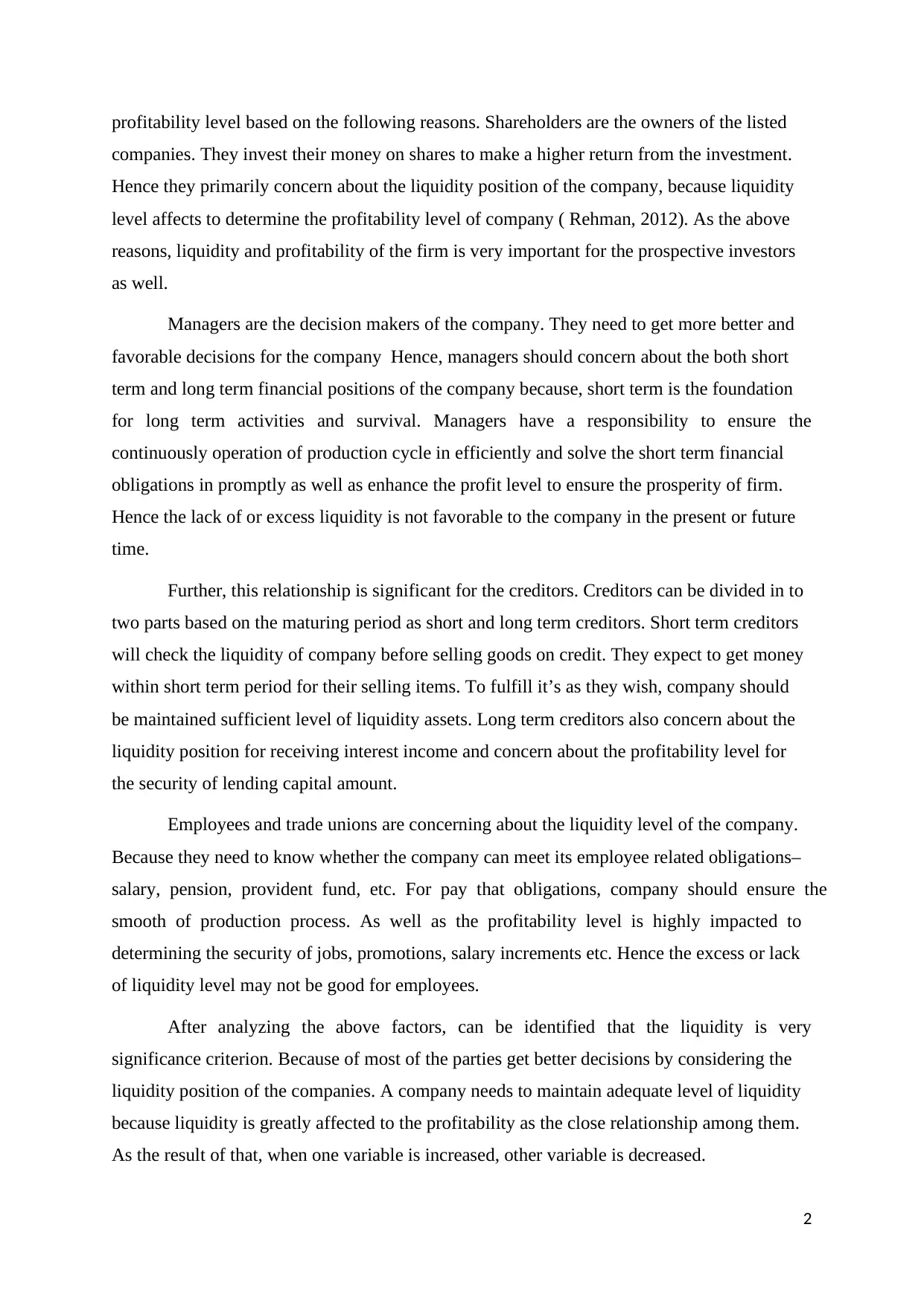
2
profitability level based on the following reasons. Shareholders are the owners of the listed
companies. They invest their money on shares to make a higher return from the investment.
Hence they primarily concern about the liquidity position of the company, because liquidity
level affects to determine the profitability level of company ( Rehman, 2012). As the above
reasons, liquidity and profitability of the firm is very important for the prospective investors
as well.
Managers are the decision makers of the company. They need to get more better and
favorable decisions for the company Hence, managers should concern about the both short
term and long term financial positions of the company because, short term is the foundation
for long term activities and survival. Managers have a responsibility to ensure the
continuously operation of production cycle in efficiently and solve the short term financial
obligations in promptly as well as enhance the profit level to ensure the prosperity of firm.
Hence the lack of or excess liquidity is not favorable to the company in the present or future
time.
Further, this relationship is significant for the creditors. Creditors can be divided in to
two parts based on the maturing period as short and long term creditors. Short term creditors
will check the liquidity of company before selling goods on credit. They expect to get money
within short term period for their selling items. To fulfill it’s as they wish, company should
be maintained sufficient level of liquidity assets. Long term creditors also concern about the
liquidity position for receiving interest income and concern about the profitability level for
the security of lending capital amount.
Employees and trade unions are concerning about the liquidity level of the company.
Because they need to know whether the company can meet its employee related obligations–
salary, pension, provident fund, etc. For pay that obligations, company should ensure the
smooth of production process. As well as the profitability level is highly impacted to
determining the security of jobs, promotions, salary increments etc. Hence the excess or lack
of liquidity level may not be good for employees.
After analyzing the above factors, can be identified that the liquidity is very
significance criterion. Because of most of the parties get better decisions by considering the
liquidity position of the companies. A company needs to maintain adequate level of liquidity
because liquidity is greatly affected to the profitability as the close relationship among them.
As the result of that, when one variable is increased, other variable is decreased.
profitability level based on the following reasons. Shareholders are the owners of the listed
companies. They invest their money on shares to make a higher return from the investment.
Hence they primarily concern about the liquidity position of the company, because liquidity
level affects to determine the profitability level of company ( Rehman, 2012). As the above
reasons, liquidity and profitability of the firm is very important for the prospective investors
as well.
Managers are the decision makers of the company. They need to get more better and
favorable decisions for the company Hence, managers should concern about the both short
term and long term financial positions of the company because, short term is the foundation
for long term activities and survival. Managers have a responsibility to ensure the
continuously operation of production cycle in efficiently and solve the short term financial
obligations in promptly as well as enhance the profit level to ensure the prosperity of firm.
Hence the lack of or excess liquidity is not favorable to the company in the present or future
time.
Further, this relationship is significant for the creditors. Creditors can be divided in to
two parts based on the maturing period as short and long term creditors. Short term creditors
will check the liquidity of company before selling goods on credit. They expect to get money
within short term period for their selling items. To fulfill it’s as they wish, company should
be maintained sufficient level of liquidity assets. Long term creditors also concern about the
liquidity position for receiving interest income and concern about the profitability level for
the security of lending capital amount.
Employees and trade unions are concerning about the liquidity level of the company.
Because they need to know whether the company can meet its employee related obligations–
salary, pension, provident fund, etc. For pay that obligations, company should ensure the
smooth of production process. As well as the profitability level is highly impacted to
determining the security of jobs, promotions, salary increments etc. Hence the excess or lack
of liquidity level may not be good for employees.
After analyzing the above factors, can be identified that the liquidity is very
significance criterion. Because of most of the parties get better decisions by considering the
liquidity position of the companies. A company needs to maintain adequate level of liquidity
because liquidity is greatly affected to the profitability as the close relationship among them.
As the result of that, when one variable is increased, other variable is decreased.
⊘ This is a preview!⊘
Do you want full access?
Subscribe today to unlock all pages.

Trusted by 1+ million students worldwide
1 out of 38
Your All-in-One AI-Powered Toolkit for Academic Success.
+13062052269
info@desklib.com
Available 24*7 on WhatsApp / Email
![[object Object]](/_next/static/media/star-bottom.7253800d.svg)
Unlock your academic potential
Copyright © 2020–2025 A2Z Services. All Rights Reserved. Developed and managed by ZUCOL.


